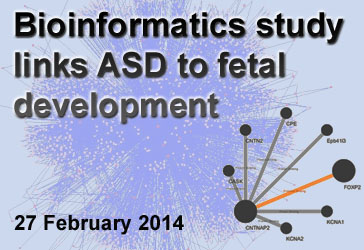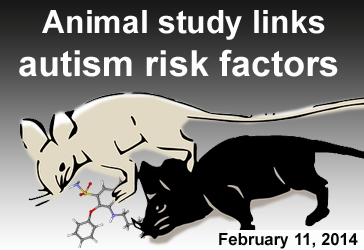Archives
February, 2014
Select a different month in the archive
Bioinformatics Links ASD to Stage of Fetal Development
By Sabina Muend, PhD on February 27, 2014

Background: Researchers have now linked several hundred genes to Autism Spectrum Disorder (ASD). Given the large number of genetic variations implicated in ASD, it is unfeasible to understand how all of these genes—and the proteins they encode—connect using experimental techniques. Therefore, researchers use bioinformatics, the process of organizing, storing, and retrieving data for analyses. One such use of bioinformatics is to make protein networks, also known as “interactomes,” which map how proteins function together in a cell.
What’s new: Two recent papers, both published in the scientific journal Cell, used bioinformatics to study the timing of brain development and the parts of the brain that are most associated with ASD. In the first analysis, a collaboration of researchers from across the United States found that 13 to 24 weeks post conception is a particularly sensitive time period based on the level of ASD-related gene products in a specific type of neuron. In the second study, University of California, Los Angeles, researchers used protein interactome mapping to link ASD with specific intracellular pathways. For instance, the interactome revealed that many of the ASD-related genes are highly expressed during synaptic development—a critical process for establishing neuron communication and brain circuitry.
Why it’s important: Based on these studies, and others like them, bioinformatics can help us understand complex disorders as well as basic cellular functioning. In the case of ASD, protein interactomes can tweeze out sensitive stages and locations of development where the impact of ASD-related genes is the greatest. Researchers hope this information could aid in the creation of finely tuned treatments.
Help me understand :
| Source(s) : |
| Tweet |
Drug Sheds Light on Underlying Cause of Autism
By Shana R. Spindler, Ph.D. on February 11, 2014

Background: With so many different genetic and environmental influences on autism, researchers are seeking a common link among risk factors. One thought is that different risk factors affect neuron function through a similar mechanism. For example, during birth there are maternal hormones that help the fetus deal with the stress of delivery and prepare the brain for post-natal development. Recent research suggests that understanding the dynamics of these hormones gives significant insight into newborn brain development.
What’s new: An animal study demonstrated that bumetanide, a commonly used diuretic drug, alters the effect of these maternal hormones. Researchers used two animal models of autism: one genetic and one drug-induced. In each model, the rodent’s progeny failed to undergo the typical brain changes in response to the labor hormone oxytocin. However, when the researchers administered bumetanide one day before delivery, the rodent’s offspring showed normal neuron function and fewer autism-like symptoms. According to the study, bumetanide enabled specific neurons to switch from an excitatory to an inhibitory state by changing chloride levels in the neuron.
Why it’s important: This study sheds light on autism’s underlying mechanism, linking both genetic and environmental risk factors to oxytocin’s effect on brain changes during birth. The finding, reported in the February 7, 2014, edition of Science magazine, supports a common mechanism for autism and paves the way for novel therapeutic strategies.
Help me understand :
| Source(s) : |
| Tweet |

